Jan. 20 (Bloomberg) -- Rice-production growth in Indonesia, the world’s third-largest grower, may slow this year as an El Nino weather phenomenon parches crops, according to Bulog, the state-owned food company that manages the nation’s supplies.
Output of milled rice may expand 3 percent in 2010 after rising 5 percent to 40 million tons in 2009, according to Mohammad Ismet, an expert who helps set Bulog’s policies. That forecast assumes the government has some success in neutralizing El Nino’s impact, he said in an interview today.
El Ninos curb or delay rains across Asia and can parch crops, potentially crimping harvests of rice, sugar and palm oil while boosting prices. Thailand and the Philippines, the world’s top rice shipper and importer respectively, warned earlier this month that the weather pattern may cut their harvests.
Without government intervention, including use of drought- resistant seeds, production growth “may not be as much as 3 percent,” Ismet said in Singapore, where he’s attending a conference. Still, the Southeast Asian nation will have enough supply of the staple to meet domestic needs, he said.
Thai rice-export prices, used as an Asian benchmark, were set at $609 a metric ton on Jan. 13 compared with $607 the week before and last year’s low of $525, according to data from the Thai Rice Exporters Association. Futures in Chicago traded at $13.98 per 100 pounds today, down by 6.1 percent this year.
‘Significant Influence’
An El Nino -- caused by a warming of the equatorial Pacific Ocean -- was forecast to cause drier-than-average conditions in Indonesia in the January-to-March period, the U.S. Climate Prediction Center said on Jan. 7. The pattern, forecast to last till June, “is expected to exert significant influence on the global weather and climate in the coming months,” it said.
The last time that Indonesia had a moderate El Nino similar to conditions the country is now experiencing was in 2006, when rice output grew 0.5 percent, Ismet said. That compares with growth of about 5 percent a year from 2007 to 2009, he said.
The price of rice in the domestic market has risen 6 percent this month compared with October as supply tightened after the El Nino delayed planting from November to December, he said. “Price is the best indicator for the market, whether the supply is enough or not for the consumption,” he said.
Bulog is forecast to buy 3.5 million tons of rice from farmers to sell to the poor at subsidized rates, helping to cool prices, Ismet said. The nation of about 232 million people has per capita consumption of 139.42 kilograms, he said.
Thailand may see a drop in rice output of as much as 15 percent to 27 million tons, Apichart Jongskul, secretary general of the nation’s Office of Agricultural Economics, said on Jan. 13. The Philippines may lose 400,000 tons from this year’s first rice harvest on El Nino, Joel Rudinas, acting agriculture undersecretary for operations, said on Jan. 18.

 Farmers carry paddy from a field in Rangunia. The government recorded a rise in aman output but the price of the staple is still high.Photo: Zobaer Hossain Sikder
Farmers carry paddy from a field in Rangunia. The government recorded a rise in aman output but the price of the staple is still high.Photo: Zobaer Hossain Sikder
